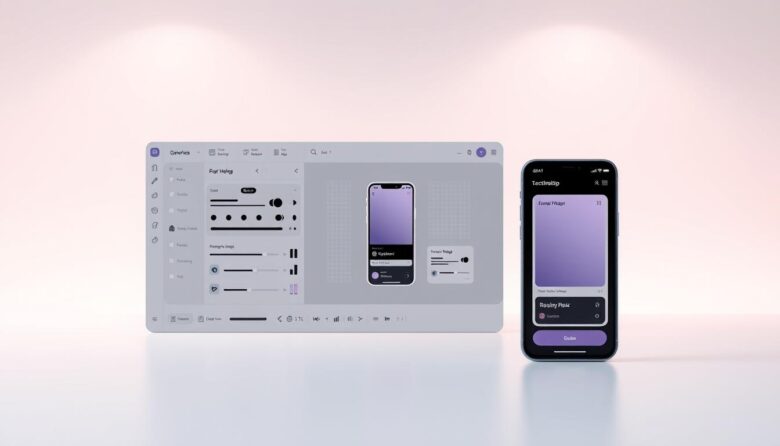The digital landscape has entered a new era of creativity. Modern development workflows now harness advanced technologies to turn ideas into polished interfaces faster than ever. Tools powered by intelligent systems allow teams to streamline complex processes, merging human vision with computational precision.
These solutions analyze text inputs through machine learning frameworks, producing functional prototypes in minutes. What once required weeks of manual work now unfolds through collaborative iterations between creators and algorithms. Professionals across industries leverage this approach to explore diverse visual concepts without sacrificing technical precision.
The shift toward automated assistance redefines traditional roles. Developers gain more time to refine user experiences, while product managers test variations efficiently. This methodology doesn’t replace expertise—it amplifies it by handling repetitive tasks and generating baseline structures.
Mastering text-based interface generation unlocks strategic advantages. Teams maintain creative oversight while accelerating project timelines. Early adopters report 70% faster iteration cycles compared to conventional methods, according to recent industry surveys.
Introduction: The Evolution of App UI Design with AI
Creative workflows have undergone radical transformation in recent years. Intelligent systems now reshape how professionals approach visual problem-solving, merging technical precision with human ingenuity.
Emergence of Intelligent Systems
Traditional methods required hours of manual adjustments. Today’s platforms interpret text prompts to generate polished layouts automatically. These solutions handle everything from component alignment to accessibility checks, producing ready-to-use prototypes.
Early automation focused on basic tasks like resizing elements. Modern systems analyze user intent through natural language processing. This shift enables teams to explore multiple concepts simultaneously without technical bottlenecks.
Redefined Creative Roles
Professionals now spend less time on repetitive actions. Generating color schemes, testing typography combinations, and exporting assets happen through streamlined commands. Freed from technical execution, creators focus on strategic decisions and user experience refinement.
New hybrid skills emerge as teams guide intelligent platforms. Prompt engineering replaces pixel-perfect adjustments. Collaboration between human intuition and algorithmic precision yields solutions that balance innovation with functional requirements.
This evolution democratizes high-quality output. Teams without coding expertise craft professional interfaces using conversational inputs. The process becomes iterative, with rapid revisions accelerating project timelines.
Understanding AI App UI Design: Definition and Benefits
Modern technology reshapes how visual concepts become functional interfaces. Intelligent platforms now interpret text inputs to produce layouts that balance aesthetics with usability. This method streamlines workflows while preserving human oversight.
What Constitutes AI App UI Design
These systems analyze language patterns to generate interface elements. They merge machine learning with established principles, ensuring outputs meet accessibility standards. Creators input text commands instead of manually adjusting pixels.
Solutions cross-reference industry trends to suggest modern layouts. Color palettes and typography pairings adapt to project goals automatically. This reduces guesswork while maintaining brand consistency across screens.
Key Advantages for Designers
Time efficiency stands out as the primary benefit. Teams generate multiple variations in minutes, accelerating prototyping phases. Automated quality checks minimize revision cycles.
Vast pattern libraries inspire fresh ideas without endless searches. The technology proposes unexpected combinations that spark creativity. Professionals then refine these suggestions into polished experiences.
Resource allocation improves as routine tasks shift to intelligent tools. Teams focus on strategic decisions like user flow optimization. This balance between automation and expertise drives 70% faster project completion reported by early adopters.
Featured Product Roundup: Top Tools for AI App UI Design
Navigating the crowded market of creative solutions requires a filter for genuine value. After testing nearly 20 platforms with identical prompts, patterns emerged between tools that deliver and those that disappoint. This roundup highlights systems producing actionable results rather than random outputs.
Criteria for Selection
Every featured platform underwent rigorous evaluation using standardized prompts. The process prioritized practical functionality over marketing claims. Tools needed to generate usable layouts consistently across multiple test scenarios.
Integration with industry-standard software like Figma proved critical. Solutions offering seamless exports reduced workflow friction for teams. Design quality assessments focused on component alignment, accessibility standards, and visual hierarchy.
Free tiers received equal scrutiny alongside premium features. Cost-benefit ratios determined whether platforms served solo creators or enterprise groups. Only tools producing cohesive designs from wireframes to mockups earned inclusion.
Reliability separated contenders from pretenders. Systems requiring constant manual adjustments failed the stress test. The final selection empowers users to transform text inputs into polished interfaces without guesswork.
In-Depth Look at Wireframe Designer
Streamlined tools are changing how teams approach early-stage prototyping. Wireframe Designer stands out as a Figma plugin that converts text prompts into structured layouts quickly. Its free tier allows 10 generations per project, catering to rapid concept testing across mobile and desktop formats.
Interface Simplicity and Design Grouping
The plugin’s clean workspace removes distractions. Users pick device dimensions through dropdown menus before generating wireframes. Figma’s Autolayout integration automatically groups buttons, text fields, and navigation bars into editable clusters.
This structure lets teams modify individual elements without breaking alignment. Sections remain responsive during resizing, maintaining spatial relationships. The approach saves hours typically spent on manual layer organization.
Mixed Performance and Results
While efficient for basic layouts, the tool occasionally inserts unrelated icons or placeholder text. These quirks require manual cleanup when prompts lack specificity. Simpler requests like “e-commerce product page” yield coherent results faster than complex scenarios.
Consistency varies across generations—some wireframes follow modern conventions perfectly, while others mix outdated components. Teams should view outputs as starting points rather than final drafts, allocating time for refinement.
Exploring UX Pilot for Seamless Design Assistance
Comprehensive solutions now streamline entire project lifecycles from concept to polished visuals. UX Pilot positions itself as an all-in-one platform for teams seeking unified workflows across discovery, prototyping, and final execution.
Low-fi to High-fi Design Options
The platform’s flexibility shines through its fidelity choices. Users generate basic wireframes for early brainstorming or detailed mockups ready for stakeholder reviews. This adaptability supports both rapid iteration and precision refinement.
Low-fidelity outputs focus on structure and flow, ideal for validating concepts. High-fidelity versions include color schemes and typography pairings, reducing manual adjustments. Teams switch between modes as projects evolve, maintaining consistency across stages.
Enhance Prompt Feature
UX Pilot’s standout text refinement tool elevates input quality. It analyzes initial descriptions to suggest clearer phrasing and additional details. This collaborative approach bridges the gap between vague ideas and actionable specifications.
Integrated with Figma, the tool accelerates workflow transitions. While the plugin has some constraints compared to the web version, it enables direct edits within familiar interfaces. Free tier users gain basic functionality, but premium unlocks advanced features for complex projects.
Spotlight on Uizard: Transforming UI Generation
Innovative platforms are redefining how teams approach interface creation. Uizard emerges as a frontrunner with end-to-end solutions that handle everything from initial concepts to polished deliverables. Unlike single-screen generators, it produces complete systems with interconnected flows in one cycle.
End-to-End Design Capability
The platform generates user flows and multiple screens simultaneously. This holistic approach ensures consistency across navigation patterns and visual elements. Teams receive ready-to-refine templates that maintain brand alignment while saving hours of manual work.
Innovative Chatbot and Component Library
Uizard’s conversational assistant lets users modify layouts through natural language commands. Request spacing adjustments or color changes without touching editing tools. The library offers pre-built elements like buttons and forms for quick integration.
Unique screenshot design conversion turns existing interfaces into editable files. Interactive prototyping keeps projects contained within one system, eliminating tool-switching. While outputs need final polishing, the platform accelerates early-stage development significantly.
Review of Galileo AI: Achieving High-Fidelity Designs
Delivering polished interfaces requires tools that balance precision with creative flexibility. Galileo AI stands out by transforming text inputs into production-ready visuals, particularly excelling in scenarios demanding presentation-grade outputs.
Visual Quality and Revision Options
The platform generates high-fidelity designs rivaling manual craftsmanship. Sophisticated layouts emerge with cohesive color schemes and typography pairings that meet professional standards. Users can refine results through conversational prompts, though revision effectiveness depends on request specificity.
Effortless Figma Integration
Galileo streamlines workflows through one-click transfers to Figma. Designers copy entire screens or components directly into their projects, bypassing tedious export processes. This seamless compatibility preserves layer structures for efficient editing.
A community gallery showcases creations from other users, complete with original prompts. This feature sparks inspiration while demonstrating practical applications of the tool. Teams leverage shared examples to refine their own input strategies and accelerate project timelines.



